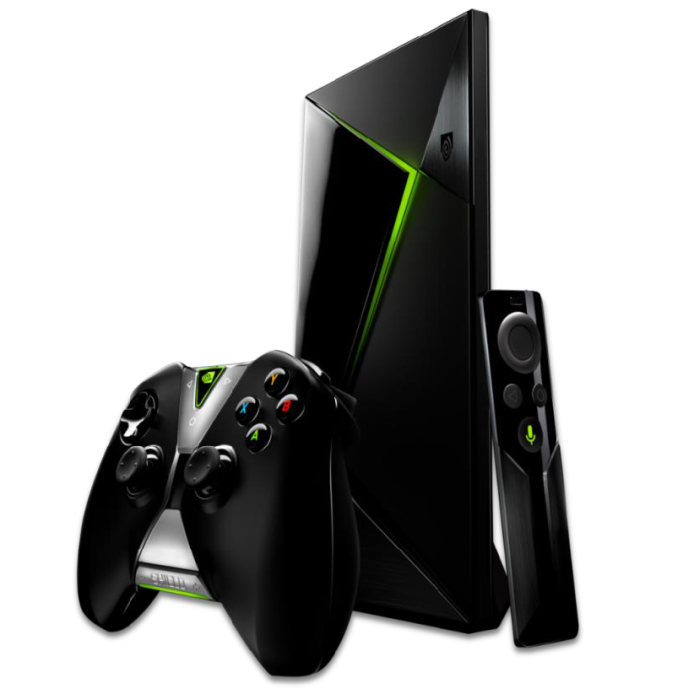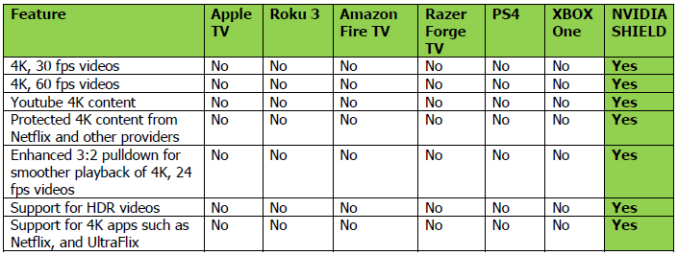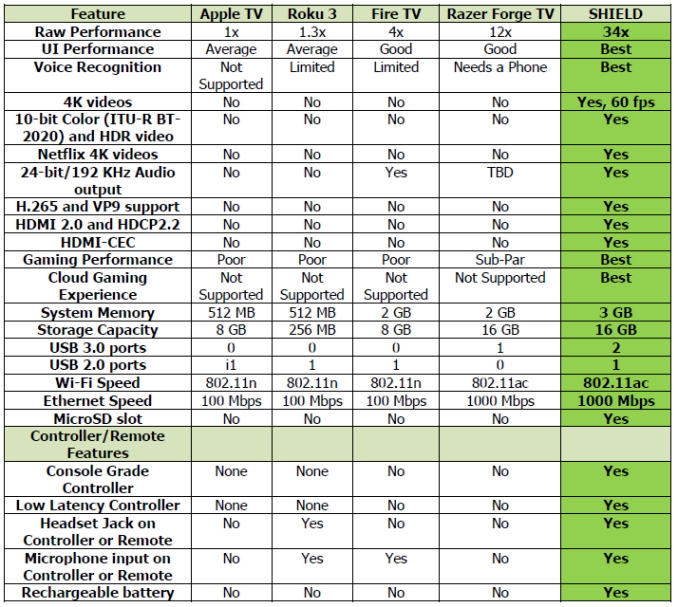The NVIDIA SHIELD Android TV Review: A Premium 4K Set Top Box
by Ganesh T S on May 28, 2015 3:00 PM EST- Posted in
- Media Streamer
- Home Theater
- TV
- 4K
- Shield
- NVIDIA

The battle for the living room (i.e, controlling the television experience) is heating up with forays from multiple vendors. As the cord-cutting trend gains momentum, the time seems to be right for disruption. Roku has been around for a long time and they continue to taste success with inexpensive and small over-the-top set-top boxes (OTT STBs). At the other end of the spectrum is the Apple TV, which, despite just being a 'hobby', has managed to move millions of units. Google had tried to make inroads into this market a few years back with the Google TV / Logitech Revue, but, it unfortunately didn't pan out as expected. Chromecast turned out to be more popular in their second attempt, but it was a limited play. In late 2014, Google launched Android TV along with the Nexus Player.
Coinciding with Google I/O, NVIDIA is releasing their previously announced SHIELD Android TV. First announed back in March at the 2015 Game Developers Conference, SHIELD Android TV is a premium 4K-capable over-the-top set-top box (OTT STB) with a powerful graphics engine. The differentiating aspects compared to the Intel Bay Trail-based Nexus Player and the Qualcomm Snapdragon-based Razer Forge TV lie in 4K support (HDMI 2.0 / HDCP 2.2 / Netflix 4K-certification) and excellent gaming credentials.
| NVIDIA SHIELD Family | ||
| NVIDIA SHIELD Tablet | NVIDIA SHIELD Android TV | |
| SoC | Tegra K1 (2.2 GHz 4x Cortex A15r3, Kepler 1 SMX GPU) | Tegra X1 (4x Cortex A57 + 4x Cortex A53, Maxwell 2 SMM GPU) |
| RAM | 2 GB LPDDR3-1866 | 3 GB LPDDR4-3200 |
| NAND | 16/32GB NAND + microSD | 16GB NAND + microSD + USB |
| Display | 8” 1920x1200 IPS LCD | N/A, HDMI 2.0 4Kp60 Output |
| Dimensions | 221 x 126 x 9.2mm, 390 grams | 210 x 130 x 25mm, 654 grams |
| Camera | 5MP rear camera, 1.4 µm pixels, 1/4" CMOS size. 5MP FFC | N/A |
| Battery | 5197 mAh, 3.8V chemistry (19.75 Whr) | N/A, 40W Power Adapter |
| OS | Android 5.0.1 | Android TV |
| Connectivity | 2x2 802.11a/b/g/n + BT 4.0, USB2.0, GPS/GLONASS, mini HDMI 1.4a | 2x2 802.11a/b/g/n/ac + BT 4.1/BLE, USB 3.0 + 2.0, HDMI 2.0 + HDCP 2.2, IR Receiver, Gigabit Ethernet |
| Launch Price | $299 (16GB/WiFi) + $59 (optional controller) | Basic: $199, Includes 1 SHIELD Controller Pro: $299, Adds 500GB Hard Drive |
The NVIDIA SHIELD smart TV platform comprises of three distinct products, the SHIELD console, the SHIELD wireless controller and the SHIELD remote.
The SHIELD is the main console, integrating a Tegra X1 SoC along with 3 GB of LPDDR4 DRAM and 16 GB of storage. I/O ports include two full-sized USB 3.0 host ports, a USB 2.0 micro-USB device port, GbE RJ-45 port, IR for universal remotes and 802.11ac 2x2 MIMO Wi-Fi with Bluetooth 2.1. It also includes a microSDXC slot. Video output is handled by a HDMI 2.0 port with HDCP 2.2 support.
The SHIELD Wireless Controller is the game controller bundled with the SHIELD console, and was first launched last year with the SHIELD Tablet. It uses Wi-Fi Direct for communication. A stereo headset jack and microphone are integrated. It also includes a rechargeable battery that can provide up to 40 hours of battery life.
Finally, the SHIELD Remote It is meant to be a replacement for the game controller in situations where single-handed operation is preferable. It uses Bluetooth for communication with the console. Like the game controller, a microphone and headset jack are included. The rechargeable battery is good for up to 4 weeks.
While the game controller and the console together retail in the basic package for $199, the SHIELD Remote is available separately for $50. Meanwhile after a slight snafu where it was announced back in April and then immediately pulled, NVIDIA is indeed offering a higher-end Pro SKU. SHIELD Pro model is similar to the SHIELD described above, except it adds an internal 500 GB hard drive into the mix and bundles a game - Borderlands: The Pre-Sequel! The Pro model is priced at $299.
Prior to diving into the details, let us take a look at the devices that NVIDIA is positioning the SHIELD Android TV against. Note that the two tables below are direct from NVIDIA's marketing material.
As we will see further down in the review, the above table is not far from the truth. In fact, except for NVIDIA claiming that their pulldown algorithm is enhanced compared to the competition, we tend to agree with everything. For the moment at least, NVIDIA pretty much has the 4K set top box to themselves.
NVIDIA claims a 34x raw performance increase compared to other OTT STB platforms. We won't endorse that particular number, but, in general, the performance of the SHIELD is miles ahead of the competition. The only other entry we find contentious is the availability of 24-bit / 192 KHz audio output. As we will see in the local media playback evaluation section, this is something of a moot point in most scenarios since the unit doesn't have licenses for decoding lossless HD audio. In any case, the above tables give an idea of where NVIDIA is positioning the SHIELD Android TV in the market.
The NVIDIA SHIELD Android TV also happens to be the first shipping product with the Tegra X1 SoC. We will first analyze the SoC and its performance in detail before moving on to Android TV in general and the SHIELD in particular.













167 Comments
View All Comments
hero4hire - Monday, June 1, 2015 - link
The question is not a matter of capablability but of utility. A $20-$30 chromecast does most of the functions. A smart TV by itself can do some. The Shield is a luxury device. Using nothing or a Roku on bottom to a ps4 or a htpc on top. Fitting in the middle and attacking a niche is this product.What does the more capable processor provide I've alternatives and am I willing to pay a little more for significantly more capability? That's the value question.
Yojimbo - Thursday, May 28, 2015 - link
"Though it’s a bit of circular logic to say that NVIDIA is intending to exploit these same advantage in the SoC space as they have the desktop space – after all, Maxwell was designed for SoCs first – Maxwell’s capabilities are clearly established at this point."There's a difference between circular logic and redundancy (much like there is a difference between circular logic and a tautology). To say that NVIDIA is intending to exploit the power-efficiency in the SOC space is simply redundant after you already said that NVIDIA designed the architecture that way in the first place. The citing of power efficiency in desktop products is simply giving evidence of power-efficiency. There's no implication of EXTRA power efficiency more than what was originally designed in the architecture by moving from desktop GPUs to the SOC GPUs. How can circular logic appear when no implication is being made?
testbug00 - Thursday, May 28, 2015 - link
"Ultimately it’s clear that the SHIELD Android TV is heavily overspeced compared to other Android TV devices – no one else is pursuing this premium market..."Perhaps because the market isn't large enough to justify a product aimed solely at it? Nvidia can leverage their streaming GPU stuff and a bunch of other stuff no other players really have.
Even with that, I don't think the market is large enough to support one player.
UltraWide - Thursday, May 28, 2015 - link
If I use a receiver and send the audio via bitstream to the receiver, will it play or not? I don't see why bitstreaming of audio requires a license? I thought the license is only required to actually decode the audio on the device and play some downmixed version of it.ganeshts - Thursday, May 28, 2015 - link
Try convincing Dolby, DTS and NVIDIA together :) I am with you on this one, but NVIDIA says licensing is the issue.cfenton - Thursday, May 28, 2015 - link
How does it handle external storage of apps? Android has typically been OK about reading media from an SD card, but it's recently been more and more restrictive about how apps can interact with external storage. Does Android TV (or some Nvidia custom magic) solve that problem? With only 16GB internal (and surely less user accessible) it will quickly run out of room if you want to install games. Recent experience with an Xperia Z3 and Nvidia Shield Tablet have not been promising on this front, at least without root access. The Xperia will copy some data to the external storage device, but still leave some on the internal, and the Shield Tablet is really picky about what games it will transfer to external storage. I'd want to just plug a 2TB portable drive into this thing, have it install everything there, and never think about it again, but based on past experience I'm worried that won't work.I know they want people to use GRID, but until data caps go away that won't be practical in many places.
Ryan Smith - Thursday, May 28, 2015 - link
The SATV can handle apps on SD cards. In fact it has a feature to automatically move newly downloaded apps to the SD card in order to better utilize the space it provides.docbones - Thursday, May 28, 2015 - link
Application support is going to be the biggest item. Will it be updated to run current Amazon Prime, Max Go, HBO Go, CW streaming, etc.Currently none of the Android TV type devices have parity to the number of streaming video apps that my phone does.
chizow - Thursday, May 28, 2015 - link
I didn't have much interest in this product or any of the previous Shield products, but with Windows Media Center's impending doom with Win10 and the prospect of Silicon Dust's HD HomeRun DVR as a viable replacement, I may have to look into getting one.It certainly seems to pack a lot of value and possibilities into a very small price tag of $200. I'm just not sure on the naming/branding, but I guess they think the Android TV aspect may have a higher demand than some of the gaming initiatives they are slowly building upon.
testbug00 - Thursday, May 28, 2015 - link
they really should make a $150 version that is just the console. Probably would increase sales quite a bit... Although, the controller and stuff is probably well under $50 to make however.